Hitler

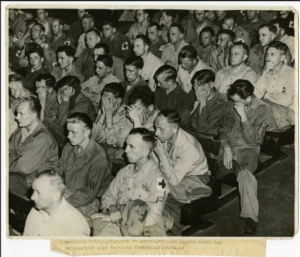 Adolf Hitler was quite possibly one of the most insane people of all time, but apparently much of the hateful things he did were actually done under the influence of Opioids and Meth. Does that excuse his behavior? Absolutely not. Even on opioids and meth, there was a monster that existed deep on the inside of that man. There was a deep-seated hatred that made him do the things he did. The opioids and meth merely gave him the ability to continue on in his hatred, and it wasn’t just Hitler that was regularly using these drugs to carry out their hateful tasks. It is common knowledge that many of the soldiers under Hitler either didn’t know the truth of everything that was going on, and still others were afraid to argue the point for fear of their own death. For many of those people, the use of drugs was the only escape from the horrors of what they had to do.
Adolf Hitler was quite possibly one of the most insane people of all time, but apparently much of the hateful things he did were actually done under the influence of Opioids and Meth. Does that excuse his behavior? Absolutely not. Even on opioids and meth, there was a monster that existed deep on the inside of that man. There was a deep-seated hatred that made him do the things he did. The opioids and meth merely gave him the ability to continue on in his hatred, and it wasn’t just Hitler that was regularly using these drugs to carry out their hateful tasks. It is common knowledge that many of the soldiers under Hitler either didn’t know the truth of everything that was going on, and still others were afraid to argue the point for fear of their own death. For many of those people, the use of drugs was the only escape from the horrors of what they had to do.
Still, there were many people who were truly evil, and it’s quite likely that those people simply used the drugs to “enhance” the horrific experience, and by enhance, I mean they very much enjoyed the killing and in their twisted minds, the use of the drugs made it more “pleasurable” to do the things they did. The drugs also kept the Nazis awake for many more hours than they might otherwise have been able to endure. The Nazi call was “Germany awake!” The orders were constantly barked out, and they meant it more than most people even knew. As Nazi Germany battled its way through World War II, the country relied on a little secret to stay “energetic.” It was known as Pervitin. It was used by the soldiers to avoid sleep and to numb the terror of battle. Housewives later popped Pervitin so they could “finish all their chores and lose weight” too. It turns out, however, that it was just pure methamphetamine. And Adolf Hitler himself relied on even stronger remedies, taking a drug called Eukodal, effectively a cocktail of oxycodone and cocaine, to treat various “ailments.”
By 1941, a top German health minister wrote a letter fretting that the entire nation was “becoming addicted to drugs” but it made little difference to Hitler or anyone else. Indeed, there remains a “trove of weird historical facts about drug use in Nazi Germany” that would totally astound even World War II buffs. We already knew that Hitler was evil and crazy, but now we know more about how he was able to keep going with all his hate. 
 For some or most of the soldiers, it was likely a way to control what they did. I’m sure a ‘mutiny” would have been catastrophic for Hitler’s master plan against the Jews. When some of those soldiers saw the atrocities that occurred, they actually wept. Many of them had no idea what was really going on…and I’m sure that was exactly what Hitler wanted.
For some or most of the soldiers, it was likely a way to control what they did. I’m sure a ‘mutiny” would have been catastrophic for Hitler’s master plan against the Jews. When some of those soldiers saw the atrocities that occurred, they actually wept. Many of them had no idea what was really going on…and I’m sure that was exactly what Hitler wanted.

 Japan entered World War I as a member of the Allies on August 23, 1914. Assisting the Allies with the war effort was not their reason for doing so, however. Once in, Japan seized the opportunity of Imperial Germany’s distraction with the European War to expand its sphere of influence in China and the Pacific. Because Japan already had a military alliance with Britain, there was minimal fighting as they pushed through to make their territorial gains. Japan was not pressured to enter the war. The Allies had things well in hand, so their motive was obvious. As they swept through, they quickly acquired Germany’s scattered small holdings in the Pacific and on the coast of China. While those holdings were relatively easy to overtake, not all of Germany’s holdings were so easy.
Japan entered World War I as a member of the Allies on August 23, 1914. Assisting the Allies with the war effort was not their reason for doing so, however. Once in, Japan seized the opportunity of Imperial Germany’s distraction with the European War to expand its sphere of influence in China and the Pacific. Because Japan already had a military alliance with Britain, there was minimal fighting as they pushed through to make their territorial gains. Japan was not pressured to enter the war. The Allies had things well in hand, so their motive was obvious. As they swept through, they quickly acquired Germany’s scattered small holdings in the Pacific and on the coast of China. While those holdings were relatively easy to overtake, not all of Germany’s holdings were so easy.
In fact, the other Allies quickly started to realize that Japan’s motives weren’t exactly in everyone’s best interests, and they began to push back hard against Japan’s efforts to dominate China through the Twenty-One Demands of 1915. Japan’s occupation of Siberia against the Bolsheviks failed, as its wartime diplomacy and limited military action produced few results. Then, by the time of the Paris Peace Conference in 1919, Japan was largely frustrated in its ambitions. Nevertheless, Japan had snapped up Germany’s Asian colonies with ease, and even the African colony of Togoland (now Togo and parts of Ghana) fell in less than three weeks. The first real sign of resistance was when German Kamerun (Cameroon) was invaded and lightly contested until 1916. Still, it fell in the end. It seemed that Japan was undefeatable.
Nevertheless, with all the victories, the German colonies in East Africa led by the formidable and undefeated Paul von Lettow-Vorbeck proved to be the exception to the rule. The situation facing von Lettow-Vorbeck and his colonial forces was formidable. Still, von Lettow-Vorbeck knew how to fight, and he refused to back down. When the Japanese came up against von Lettow-Vorbeck, they found themselves heavily outnumbered, and they found themselves with no prospect of reinforcements or much in the way of material support arriving anytime soon.
The fact was that von Lettow-Vorbeck was seeking to tie up British military resources in Africa to relieve some pressure on the European theater. He drew upon his many years of service in Africa to wage a highly effective guerilla war against a much larger enemy. Von Lettow-Vorbeck was probably one of the greatest guerilla warfare strategists of all time…maybe the greatest. Von Lettow-Vorbeck even gained the loyalty of his African soldiers. In those days, it was highly unusual for a commanding officer or any white soldier for that matter, to show any level of respect to the African soldiers. Von Lettow-Vorbeck did, by appointing Black officers and speaking Swahili. The German troops had learned to live off the land and make the most of very little supplies, due to hard lessons drawn from years of colonial warfare in Africa. Those years were filled with atrocities, but they had persevered.
This one small German colonial army tied up the British forces for the duration of the conflict. The British had been plundering food 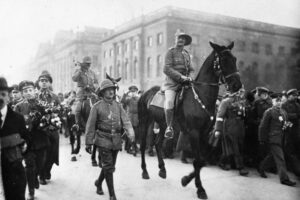 supplies that devastated the local population. Finally, the German army surrendered on November 25, 1918, in Zambia, two weeks after the November 11, 1918 armistice ended hostilities. Of course, Hitler knew a great officer when he saw one, and so after the war, Hitler immediately offered von Lettow-Vorbek a prestigious position in the Third Reich. In what most would consider a complete shock, von Lettow-Vorbeck bluntly refused the offer, using some very “colorful” language, which shall not be repeated here. It was a courageous, but not very wise move, given the circumstances. Nevertheless, his boldness, as well as his loyalty to the German people, paid off. Von Lettow-Vorbeck was simply too popular with the German people to be eliminated by the regime. He lived to be 94.
supplies that devastated the local population. Finally, the German army surrendered on November 25, 1918, in Zambia, two weeks after the November 11, 1918 armistice ended hostilities. Of course, Hitler knew a great officer when he saw one, and so after the war, Hitler immediately offered von Lettow-Vorbek a prestigious position in the Third Reich. In what most would consider a complete shock, von Lettow-Vorbeck bluntly refused the offer, using some very “colorful” language, which shall not be repeated here. It was a courageous, but not very wise move, given the circumstances. Nevertheless, his boldness, as well as his loyalty to the German people, paid off. Von Lettow-Vorbeck was simply too popular with the German people to be eliminated by the regime. He lived to be 94.
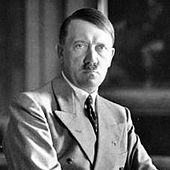
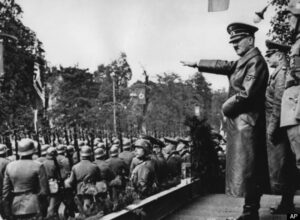 There are certain situations when I think citizenship is a must have element, and some that I think “natural-born” citizenship is absolutely essential. On September 15, 1935, German Jews were stripped of their citizenship, reducing them to mere “subjects” of the state. This heinous crime was carried out by the “president and chancellor of Germany,” Adolf Hitler. I use the quotation marks, because Hitler should never have been allowed to be in that office. Adolf Hitler became a citizen of Germany on February 25, 1932. Hitler, who was born in Austria, had immigrated to Germany in 1913, and renounced his Austrian citizenship in 1925. Hitler was a stateless nomad from 1925 to 1931, when he decided on the political ambition of becoming president and chancellor. That was when he decided to become a citizen, in fact that was the only reason he became a citizen. Hitler had a plan to take over and completely transform Germany, and his “transformation” was to be the worst thing for Germany. I think that is why a president needs to be a “natural-born” citizen. A president needs to have a connection to his country…a connection he is born into. Then and only then does he have the ability to care about the country…not that all presidents do, but they have that ability, because they belong. I’m sure some would disagree with me, but it will not change my mind.
There are certain situations when I think citizenship is a must have element, and some that I think “natural-born” citizenship is absolutely essential. On September 15, 1935, German Jews were stripped of their citizenship, reducing them to mere “subjects” of the state. This heinous crime was carried out by the “president and chancellor of Germany,” Adolf Hitler. I use the quotation marks, because Hitler should never have been allowed to be in that office. Adolf Hitler became a citizen of Germany on February 25, 1932. Hitler, who was born in Austria, had immigrated to Germany in 1913, and renounced his Austrian citizenship in 1925. Hitler was a stateless nomad from 1925 to 1931, when he decided on the political ambition of becoming president and chancellor. That was when he decided to become a citizen, in fact that was the only reason he became a citizen. Hitler had a plan to take over and completely transform Germany, and his “transformation” was to be the worst thing for Germany. I think that is why a president needs to be a “natural-born” citizen. A president needs to have a connection to his country…a connection he is born into. Then and only then does he have the ability to care about the country…not that all presidents do, but they have that ability, because they belong. I’m sure some would disagree with me, but it will not change my mind.
His citizenship actually came about when a fellow member of the Nazi Party appointed Hitler to a low-level government job that came with automatic citizenship. Once he was a citizen, Hitler’s new status allowed him to achieve his political goals. As a citizen, he could run for office. Hitler made sure that he was well liked, and by the middle of 1934, he was in complete control of Germany as Führer und Reichskanzler (leader and chancellor). He didn’t wait long to begin, and soon redefined citizenship to serve his beliefs. He was a hate-filled man, and he used race and pan-German heritage to give citizenship to, and take it from, large groups of people. Citizenship now depended on how Hitler felt about the people. Many would say that he was a white supremacist, but the reality was that there were many races of people he didn’t like, and many of them were white, so it wasn’t about color. As World War II began, Hitler’s views on German supremacy were fueling a military campaign that destroyed borders and entire populations all across Europe. People who were born in Germany and had been citizens all their lives were being systematically stripped of their citizenship, their rights, and their lives, just because they were Jews, blacks, gypsies, and some other races. Hitler’s goal was to rid the world of anyone who was not “pure-blooded” German stock. Never mind the fact that he was not!!
Practically from the minute he took office, Hitler began issuing what we would call “Executive Orders” that barely disrupted the lives of those “pure-blooded” German stock, other than to basically elevate them to the level of “masters” over anyone who did not qualify as “pure-blooded” German stock. His dream of a “pure-blooded” society soon became a nightmare for many. Many of the German “pure-blooded” German citizen didn’t agree with what he was doing, and some didn’t really understand what he was doing, exactly, but some of them saw it as an opportunity to take from the “unqualified” citizens, anything they wanted. They became brutal in their treatment of the “unqualified” citizens, especially the Jews.
Hitler began his persecution of the Jews within the first year of office. German Jews were excluded from many high-profile vocations, such as public office, journalism, radio, theater, film, and teaching, and even farming. The professions of law and medicine were also withdrawn slowly as opportunities. “Jews Not Welcome” signs were posted on shop and hotel windows, beer gardens, and other public areas. Known as the Nuremberg Laws, these discriminatory acts became a deep-seated part of the German culture, which in turn, making them even more far-reaching. Jews were forbidden to marry “Aryans” or engage in extramarital relations with them. Jews could not employ female Aryan servants if they were less than 35 years of age. Hunger soon became a part of Jewish life, because it became difficult even to buy food, as groceries, bakeries, and dairies would not admit Jewish customers. Even pharmacies refused to sell them medicines or drugs. Their lives soon began to simply spiral towards despair and eventual death.
At first, the outside world didn’t understand what they were seeing. Unemployment had dropped exponentially under Hitler’s early commandeering of the economy. Things actually looked better to the world. A very few, some foreign visitors, even some political opponents within Germany itself, saw these racist laws and practices for what they were, but most were beguiled into thinking it was merely a phase. They assumed that the “birth 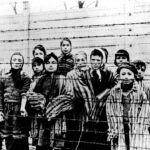
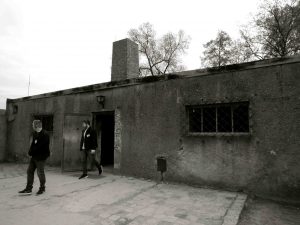 pains” of Hitler’s developing plans would eventually smooth out and the bad parts would fade away, as he began to focus more on the economy and less on race, but they were wrong, because Hitler was a very determined, and very focused dictator…and he was insane, as the world and the German people would soon find out. It is my opinion that even a seemingly good citizen, who is not “natural-born” is not a good candidate for president, because their ideas and plans for a nation they have no real stake in, will be very unlikely to produce good for the nation in the end.
pains” of Hitler’s developing plans would eventually smooth out and the bad parts would fade away, as he began to focus more on the economy and less on race, but they were wrong, because Hitler was a very determined, and very focused dictator…and he was insane, as the world and the German people would soon find out. It is my opinion that even a seemingly good citizen, who is not “natural-born” is not a good candidate for president, because their ideas and plans for a nation they have no real stake in, will be very unlikely to produce good for the nation in the end.
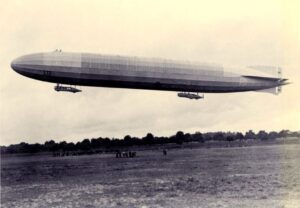 The first power-driven airship was built by a French inventor decades before the Zeppelin was developed by German inventor Ferdinand Graf von Zeppelin in 1900. The Zeppelin was a motor-driven rigid airship. The earlier airships were smaller, but Hilter always wanted the most innovative, largest, and deadliest designs of everything, with was likely the reason for the Zeppelin’s size. It was by far the largest airship ever constructed. Hitler didn’t care that size was exchanged for safety. The heavy steel-framed airships were vulnerable to explosion, because they had to be lifted by highly flammable hydrogen gas instead of non-flammable helium gas.
The first power-driven airship was built by a French inventor decades before the Zeppelin was developed by German inventor Ferdinand Graf von Zeppelin in 1900. The Zeppelin was a motor-driven rigid airship. The earlier airships were smaller, but Hilter always wanted the most innovative, largest, and deadliest designs of everything, with was likely the reason for the Zeppelin’s size. It was by far the largest airship ever constructed. Hitler didn’t care that size was exchanged for safety. The heavy steel-framed airships were vulnerable to explosion, because they had to be lifted by highly flammable hydrogen gas instead of non-flammable helium gas.
During World War I, the Zeppelins were used as bombers, and the Germans had great success bombing the British Isles with the Zeppelin over the course of 1915 and 1916. The first such 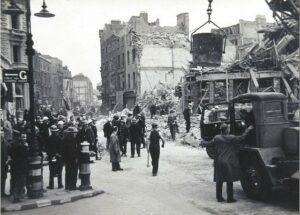 attack on London came on May 31, 1915. That bombing killed 28 people and wounded 60 more. The Germans killed a total of 550 Britons with aerial bombing by May 1916. During one such attack, on September 8, 1915, Heinrich Mathy was the commander of the famed German Zeppelin L13, bombing Aldersgate in central London. His bombs killed 22 people and causing £500,000 worth of damage.
attack on London came on May 31, 1915. That bombing killed 28 people and wounded 60 more. The Germans killed a total of 550 Britons with aerial bombing by May 1916. During one such attack, on September 8, 1915, Heinrich Mathy was the commander of the famed German Zeppelin L13, bombing Aldersgate in central London. His bombs killed 22 people and causing £500,000 worth of damage.
While Mathy was waiting on repairs to his ship, following a bombing run on August 24-25, 1916, he received word that the British had managed for the first time to shoot down a Zeppelin, using incendiary bullets. While he was a fearless pilot, Mathy saw the writing on the wall, and said, “It is only a question of time before we join  the rest. Everyone admits that they feel it. Our nerves are ruined by mistreatment. If anyone should say that he was not haunted by visions of burning airships, then he would be a braggart.” I’m sure he knew that the Zeppelin was a dangerous ship anyway, especially in a crash, but this new danger made matters much worse. As Mathy had predicted, his Zeppelin L31True to his prediction, Mathy’s L31 was shot down during a raid on London on the night of October 1-2, 1916. He is buried in Staffordshire, in a cemetery constructed by the British for the burial of Germans killed on British soil during both World Wars.
the rest. Everyone admits that they feel it. Our nerves are ruined by mistreatment. If anyone should say that he was not haunted by visions of burning airships, then he would be a braggart.” I’m sure he knew that the Zeppelin was a dangerous ship anyway, especially in a crash, but this new danger made matters much worse. As Mathy had predicted, his Zeppelin L31True to his prediction, Mathy’s L31 was shot down during a raid on London on the night of October 1-2, 1916. He is buried in Staffordshire, in a cemetery constructed by the British for the burial of Germans killed on British soil during both World Wars.
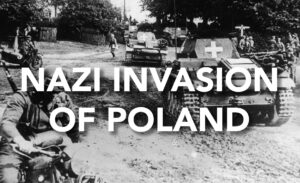 As we all know, Adolph Hitler was a liar and a murderer. He really never made a move that wasn’t calculated and devious. On September 1, 1939, German forces under the control of Adolf Hitler bombarded Poland on land and from the air. The invasion was more than just a taking of territory. Hitler knew that he might need that area later, and so he did. Hitler had been murdering people that didn’t fit into his mold of “life that had value” and that included Jews, the mentally or physically handicapped, and later gypsies and other ethnicities. Basically, he wanted to eliminate anyone that wasn’t Aryan. Aryan is a word relating to a hypothetical ethnic type illustrated by or descended from early speakers of Indo-European languages. To Hitler it meant white, with blond hair and blue eyes. Oddly, while Hitler had blue eyes, his hair was brown. Somehow that “problem” with his definition of Aryan didn’t concern Hitler. I guess he was happy to be a “special Aryan.” In reality, there are different kinds of Aryans. They can be found with blond, red, brown, white, or black hair, so that wasn’t really an issue either. Hitler considered himself Aryan because he was a native German-speaker, and he knew the definition of “Aryan” as it was used in those days. I don’t think it was ever about Aryan, per se, but rather about getting rid of any group that he decided that he didn’t like.
As we all know, Adolph Hitler was a liar and a murderer. He really never made a move that wasn’t calculated and devious. On September 1, 1939, German forces under the control of Adolf Hitler bombarded Poland on land and from the air. The invasion was more than just a taking of territory. Hitler knew that he might need that area later, and so he did. Hitler had been murdering people that didn’t fit into his mold of “life that had value” and that included Jews, the mentally or physically handicapped, and later gypsies and other ethnicities. Basically, he wanted to eliminate anyone that wasn’t Aryan. Aryan is a word relating to a hypothetical ethnic type illustrated by or descended from early speakers of Indo-European languages. To Hitler it meant white, with blond hair and blue eyes. Oddly, while Hitler had blue eyes, his hair was brown. Somehow that “problem” with his definition of Aryan didn’t concern Hitler. I guess he was happy to be a “special Aryan.” In reality, there are different kinds of Aryans. They can be found with blond, red, brown, white, or black hair, so that wasn’t really an issue either. Hitler considered himself Aryan because he was a native German-speaker, and he knew the definition of “Aryan” as it was used in those days. I don’t think it was ever about Aryan, per se, but rather about getting rid of any group that he decided that he didn’t like.
Hitler’s main purpose for the invasion of Poland was to regain lost territory and ultimately rule their eastern neighbor. Mostly, however, Hitler wanted the world to know exactly how he planned to wage war. This would become the “blitzkrieg” strategy. The Blitzkrieg was a term used to describe “a method of offensive warfare designed to strike a swift, focused blow at an enemy using mobile, maneuverable forces, including armored  tanks and air support. Such an attack ideally leads to a quick victory, limiting the loss of soldiers and artillery. After the German forces had plowed their way through, devastating a swath of territory, infantry moved in, picking off any remaining resistance.”
tanks and air support. Such an attack ideally leads to a quick victory, limiting the loss of soldiers and artillery. After the German forces had plowed their way through, devastating a swath of territory, infantry moved in, picking off any remaining resistance.”
Hitler was methodical. He established a base of operations within the target country. Then, he immediately began setting up “security” forces to take out anyone who disagreed with his Nazi ideology, whether racial, religious, or political. He set up concentration camps for slave laborers and the extermination of uncooperative civilians. It didn’t take long for the target nation, in this case Poland to become a conquered nation under German rule. Just one day after the German invasion of Poland, Hitler was busy setting up SS “Death’s Head” regiments to terrorize the people. He was preparing for his planned terror.
The Polish army tried to fight back, but they made several severe strategic miscalculations in those early days. Even with an army of 1 million soldiers, the lack of the necessary equipment was a severe detriment to the Polish forces as they attempted to take the Germans head-on, when maybe they should have fallen back to defensive positions. I think the natural way to face an enemy, is head-on. We try to “show no fear” when attacked, but in the end, this thinking, while admirable was probably behind the times, at least in battle, and the brave Polish soldiers were no match for the overwhelming and modern-mechanized German forces. To make matters worse, any hope the Polish soldiers might have had of a Soviet counter-response was lost with  the signing of the Ribbentrop-Molotov Nonaggression Pact…”a non-aggression pact between Nazi Germany and the Soviet Union that partitioned Eastern Europe between them. The pact was signed in Moscow on 23 August 1939 by German Foreign Minister Joachim von Ribbentrop and Soviet Foreign Minister Vyacheslav Molotov and was officially known as the Treaty of Non-Aggression between Germany and the Union of Soviet Socialist Republics. Unofficially, it has also been referred to as the Hitler–Stalin Pact, Nazi–Soviet Pact or Nazi–Soviet Alliance.” Germany invaded Poland on September 1, 1939. Great Britain responded with bombing raids over Germany three days later.
the signing of the Ribbentrop-Molotov Nonaggression Pact…”a non-aggression pact between Nazi Germany and the Soviet Union that partitioned Eastern Europe between them. The pact was signed in Moscow on 23 August 1939 by German Foreign Minister Joachim von Ribbentrop and Soviet Foreign Minister Vyacheslav Molotov and was officially known as the Treaty of Non-Aggression between Germany and the Union of Soviet Socialist Republics. Unofficially, it has also been referred to as the Hitler–Stalin Pact, Nazi–Soviet Pact or Nazi–Soviet Alliance.” Germany invaded Poland on September 1, 1939. Great Britain responded with bombing raids over Germany three days later.

 When countries choose sides in a war, there isn’t normally much chance that they will switch sides, but that is exactly what happened to Romania…and in fact, there were four countries that switched sides in that war, so maybe it isn’t so uncommon after all. At the start of the war Romania was allied and Poland and pro-British. They were trying to stay neutral, but that wasn’t easy. As the war progressed, Romania became more and more concerned about being overrun by the Soviet Union and the Fascist elements already in Romania. Finally, the decision was made to adopt a pro-German dictatorship and became an ‘affiliate state’ of the Axis Powers. The Romanian government signed the Tripartite Pact in November 1940. During the time that Romania supported the Axis powers, they supplied Nazi Germany and the Axis armies with oil, grain, and industrial products. Also, numerous train stations in the country, such as Gara de Nord in Bucharest, served as transit points for troops departing for the Eastern Front.
When countries choose sides in a war, there isn’t normally much chance that they will switch sides, but that is exactly what happened to Romania…and in fact, there were four countries that switched sides in that war, so maybe it isn’t so uncommon after all. At the start of the war Romania was allied and Poland and pro-British. They were trying to stay neutral, but that wasn’t easy. As the war progressed, Romania became more and more concerned about being overrun by the Soviet Union and the Fascist elements already in Romania. Finally, the decision was made to adopt a pro-German dictatorship and became an ‘affiliate state’ of the Axis Powers. The Romanian government signed the Tripartite Pact in November 1940. During the time that Romania supported the Axis powers, they supplied Nazi Germany and the Axis armies with oil, grain, and industrial products. Also, numerous train stations in the country, such as Gara de Nord in Bucharest, served as transit points for troops departing for the Eastern Front.
With all of this, Romania caught the eye of the Allies in 1943, and soon became a target for their aerial bombardment. One of the most notable air bombardments was the attack on the oil fields of Ploie?ti on August 1, 1943, known as Operation Tidal Wave. On April 4 and 15, 1944, Bucharest was subjected to intense Allied bombardment. On August 23, 1944, King Michael I removed the government of Ion Antonescu and declared Romanian support to the Allies. Then the Luftwaffe bombed the city Bucharest on August 24 and 25, 1944 in direct response to the Romania’s decision to switch sides. Some experts believe that by switching sides Romania helped shorten the war by several months. I’m sure that Romania was glad to be on the winning side of the war.
Romania was not the only nation to switch sides in Worls War II. They were Bulgaria, Finland, and Italy. Bulgaria also signed the Tripartite Pact in March of 1941, but Finland never signed it, but was nonetheless a co-belligerent on the side of the Axis Powers. Finland signed the Anti-Comintern Pact, an anti-communist agreement of mainly fascist powers, in November 1941. Italy had its own imperial ambitions, which were partly 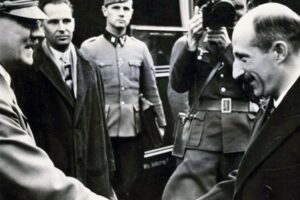
 based on the Roman Empire and similar to the German policy of lebensraum, which clashed with those of Britain and France. No matter wat their aspirations were, all of these nations decided that the ways of Germany and Hitler were simply not ways they could live with, so they switched sides, joined the Allied Nations, further weakened Hitler to the point of causing his demise.
based on the Roman Empire and similar to the German policy of lebensraum, which clashed with those of Britain and France. No matter wat their aspirations were, all of these nations decided that the ways of Germany and Hitler were simply not ways they could live with, so they switched sides, joined the Allied Nations, further weakened Hitler to the point of causing his demise.
 Hitler never had feeling of any kind toward mankind of any nationality, race, gender, or religion, even though there were those he hated more than others…specifically, Jews, Gypsies, Blacks, and anyone not blond haired and blue eyed. Nevertheless, Hitler had long ago decided that anyone was disposable, except him. He didn’t tell other people about that, of course. On July 8, 1941, the German army invaded Pskov, a city located 180 miles from Leningrad, Russia. General Franz Halder, the chief of the German army general staff recorded Hitler’s plans for Moscow and Leningrad in his diary, and it wasn’t good. Hitler planned “To dispose fully of their population, which otherwise we shall have to feed during the winter.” Basically, he considered them all to be “useless eaters” and planned to kill them. Then, he planned to turn Moscow into a lake.
Hitler never had feeling of any kind toward mankind of any nationality, race, gender, or religion, even though there were those he hated more than others…specifically, Jews, Gypsies, Blacks, and anyone not blond haired and blue eyed. Nevertheless, Hitler had long ago decided that anyone was disposable, except him. He didn’t tell other people about that, of course. On July 8, 1941, the German army invaded Pskov, a city located 180 miles from Leningrad, Russia. General Franz Halder, the chief of the German army general staff recorded Hitler’s plans for Moscow and Leningrad in his diary, and it wasn’t good. Hitler planned “To dispose fully of their population, which otherwise we shall have to feed during the winter.” Basically, he considered them all to be “useless eaters” and planned to kill them. Then, he planned to turn Moscow into a lake. 
The Germans first launched a massive invasion of the Soviet Union, called Operation Barbarossa, on June 22, using over 3 million men. Since the Soviet army was unsuspecting and unprepared, the Germans were very successful in their attack. By July 8th, the Germans had captured more than 280,000 Soviet soldiers and almost 2,600 tanks had been destroyed. With the Germans already a couple of hundred miles inside Soviet territory, Stalin was in a state of panic. He began executing any of his generals who had failed to stop the advancing attack. That was likely a big mistake, because he was basically defeating himself from the inside.
As chief of staff, Halder had been keeping a diary of Hitler’s day-to-day decision-making process. His documentation of Hitler’s processes showed the flaws that Hitler had. I don’t know if that was his plan or if he had wanted to emulate Hitler, but as became emboldened by his successes in Russia, Halder recorded that the “Fuhrer is firmly determined to level Moscow and Leningrad to the ground.” It was Halder’s opinion that Hitler  had underestimated the Russian army’s numbers and the bitter infighting between factions within the military about strategy. Halder and several others thought they should head straight to Moscow, as taking the capital would bring down the entire country. Nevertheless, Hitler was the leader, and as such, he wanted to meet up with Field Marshal Wilhelm Leeb’s army group, which was making its way toward Leningrad. The biggest mistake Hitler made was the fact that Winter was coming, and the Russians were much more used to the Soviet Winter’s frigid temperatures than the Germans…an advantage that would eventually catch up to the Germans. The advantage of such conditions would give the Russians the victory over the Germans in this battle.
had underestimated the Russian army’s numbers and the bitter infighting between factions within the military about strategy. Halder and several others thought they should head straight to Moscow, as taking the capital would bring down the entire country. Nevertheless, Hitler was the leader, and as such, he wanted to meet up with Field Marshal Wilhelm Leeb’s army group, which was making its way toward Leningrad. The biggest mistake Hitler made was the fact that Winter was coming, and the Russians were much more used to the Soviet Winter’s frigid temperatures than the Germans…an advantage that would eventually catch up to the Germans. The advantage of such conditions would give the Russians the victory over the Germans in this battle.
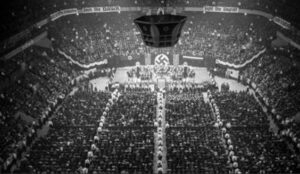
 I think that we can all say that we have found ourselves on the wrong side of history…at the very least our belief system. That is really where most of the world found themselves when Adolf Hitler was elected to office, and almost immediately began to pour out his evil plan for the world, and his hatred for anyone not Aryan, which in Nazi ideology, “denotes white non-Jewish people, especially those of northern European origin or descent typically having blond hair and blue eyes and regarded as a supposedly superior racial group.” Hitler had so deceived the world, in fact, that just a short six and a half months before Hitler invaded Poland, New York City’s Madison Square Garden hosted a rally to celebrate the rise of Nazism in Germany!! More than 20,000 people were in attendance. They raised Nazi salutes toward a 30-foot-tall portrait of George Washington flanked by swastikas. Of course, not everyone was fooled by Hitler, and in fact the 20,000 were a very small percentage, but these 20,000 were, whether they ever understood it or not, on the wrong side of history, trying to follow a man who was insanely evil, murderous, and racist. Outside, police and some 100,000 protestors, who saw right through Hitler’s beliefs, gathered.
I think that we can all say that we have found ourselves on the wrong side of history…at the very least our belief system. That is really where most of the world found themselves when Adolf Hitler was elected to office, and almost immediately began to pour out his evil plan for the world, and his hatred for anyone not Aryan, which in Nazi ideology, “denotes white non-Jewish people, especially those of northern European origin or descent typically having blond hair and blue eyes and regarded as a supposedly superior racial group.” Hitler had so deceived the world, in fact, that just a short six and a half months before Hitler invaded Poland, New York City’s Madison Square Garden hosted a rally to celebrate the rise of Nazism in Germany!! More than 20,000 people were in attendance. They raised Nazi salutes toward a 30-foot-tall portrait of George Washington flanked by swastikas. Of course, not everyone was fooled by Hitler, and in fact the 20,000 were a very small percentage, but these 20,000 were, whether they ever understood it or not, on the wrong side of history, trying to follow a man who was insanely evil, murderous, and racist. Outside, police and some 100,000 protestors, who saw right through Hitler’s beliefs, gathered.
The organization who was behind the February 20, 1939 event, was the German American Bund (“Bund” is German for “federation”), had advertised the event as a “Pro American Rally.” The antisemitic organization held Nazi summer camps for youth and their families during the 1930s. Doesn’t that sound a lot like Hitler’s Youth Camps, that later turned into just the Hitler Youth, where he forcefully took children from their parents saying that the parents were ill-equipped to properly raise their children. Then, he turned those youth into killing machines, with no regard for human life. The Bund’s youth members were present at the February 20th rally, as were the Ordnungsdienst, or OD, the group’s vigilante police force who dressed in the style of Hitler’s SS officers. In Germany, these were the Jewish Ghetto Police or Jewish Police Service (German: Jüdische, Ghetto-Polizei, or Jüdischer Ordnungsdienst), also called the Jewish Police by Jews, and they were auxiliary police units organized within the Nazi ghettos by local Judenrat (Jewish councils). Their “job” was to keep order, or rather monitor the orderly persecution and murder of the Jewish people.
At the rally, there were banners hanging with messages like “Stop Jewish Domination of Christian Americans” and “Wake Up America. Smash Jewish Communism.” When the Bund’s national leader, Fritz Kuhn, gave his closing speech, he referred to President Franklin Delano Roosevelt as “Rosenfield” and Manhattan District Attorney Thomas Dewey as “Thomas Jewey.” Kuhn, a naturalized American who lost his citizenship during World War II, declared, “We, with American ideals, demand that our government shall be returned to the American people who founded it. If you ask what we are actively fighting for under our charter: First, a socially just, white, Gentile-ruled United States. Second, Gentile-controlled labor unions, free from Jewish Moscow-directed domination.” Isadore Greenbaum, a brave Jewish-American man, interrupted Kuhn’s speech by charging the stage in protest. Undaunted, the police and the vigilante force quickly tackled him and proceeded to beat him up on stage. The crowd cheered as they threw him off stage, pulling his pants down in the process. Police charged Greenbaum with disorderly conduct and gave him a $25 fine, which today would have equaled about $450. They were not only intent on inflicting pain, but also humiliation. They are people who have stepped into the insane world of evil. Definitely the wrong side of history.
At the time the rally took place, Hitler was completing his sixth concentration camp. The protesters, many of them Jewish Americans, were trying to call attention to what was happening in Germany, saying that it could happen in the United States. Their fliers proclaimed, “Don’t wait for the concentration camps—Act now!” Outside the rally, people carried signs with messages like “Smash Anti-Semitism” and “Give me a gas mask, I can’t stand the smell of Nazis.” The police responded to the protesters with violent attacks. The night was riddled with violence. One protester escaped a mounted police officer, by punching his horse in the face. As the rally broke up, some protesters slipped by the police to punch departing Nazis in the face.
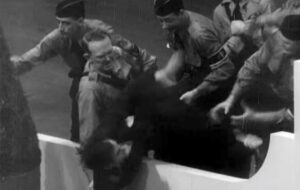
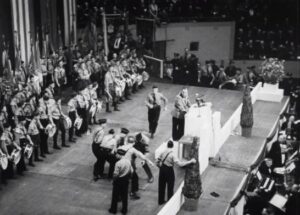 Looking back on how the Nazi history played out, and especially the atrocities of Hitler, I wonder if the people who were at the rally in support of Hitler felt about their…hero now. I suppose that being obsessed with evil, they might have been fine with the Holocaust, and all of the killing that took place. All we can hope is that maybe at least a few of then saw the error of their ways, and realized just how evil Hitler and the Third Reich really were.
Looking back on how the Nazi history played out, and especially the atrocities of Hitler, I wonder if the people who were at the rally in support of Hitler felt about their…hero now. I suppose that being obsessed with evil, they might have been fine with the Holocaust, and all of the killing that took place. All we can hope is that maybe at least a few of then saw the error of their ways, and realized just how evil Hitler and the Third Reich really were.

 On October 31, 1922, following the March on Rome, Benito Mussolini was appointed prime minister by King Victor Emmanuel III. With that appointment, he became the youngest individual to hold the office up to that time. Mussolini quickly got to work, removing all political opposition through his secret police and outlawing labor strikes. He, along with his followers consolidated power through a series of laws that transformed Italy into a one-party dictatorship. A short five years later, he had established dictatorial authority by both legal and illegal means and planned to create a totalitarian state.
On October 31, 1922, following the March on Rome, Benito Mussolini was appointed prime minister by King Victor Emmanuel III. With that appointment, he became the youngest individual to hold the office up to that time. Mussolini quickly got to work, removing all political opposition through his secret police and outlawing labor strikes. He, along with his followers consolidated power through a series of laws that transformed Italy into a one-party dictatorship. A short five years later, he had established dictatorial authority by both legal and illegal means and planned to create a totalitarian state.
Still, as often happens, the people, good government officials, and of course, God made it clear that both fascist Italy and its dictator Benito Mussolini’s days were numbered by July 1943. So, after the successful Allied invasion of Sicily, the Italian government’s Grand Council delivered Mussolini a vote of no confidence. Shortly after that, King Vittorio Emanuele III replaced Mussolini as prime minister, and immediately had him arrested.
When Adolf Hitler heard of Mussolini’s arrest, he was furious. Hitler considered Mussolini to be his most powerful European ally, and Hitler began to make plans to rescue Mussolini. He brought in SS Major Otto Skorzeny, who was considered “the most dangerous man in Europe,” for the rescue mission. The Germans had 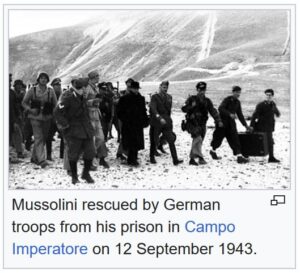 discovered that Mussolini was being held in a mountain ski resort 7,000 feet above sea level in the Abruzzo region. Due to the remoteness of the location, Skorzeny decided the only way to rescue Mussolini was to send in a dozen gliders with 108 commandos to do the job. The mission, dubbed Operation Eiche commenced on September 12, 1943. Along with the commandos, Skorzeny brought along an Italian general named Soleti. It was Soleti’s mission to create confusion among Mussolini’s guards, thereby giving the commandos time to get to Mussolini. While Soleti shouted orders at the confused guards, the commandos recaptured Mussolini without incident and flew him to a nearby Luftwaffe airfield, then to Hitler’s Wolf’s Lair headquarters in East Prussia.
discovered that Mussolini was being held in a mountain ski resort 7,000 feet above sea level in the Abruzzo region. Due to the remoteness of the location, Skorzeny decided the only way to rescue Mussolini was to send in a dozen gliders with 108 commandos to do the job. The mission, dubbed Operation Eiche commenced on September 12, 1943. Along with the commandos, Skorzeny brought along an Italian general named Soleti. It was Soleti’s mission to create confusion among Mussolini’s guards, thereby giving the commandos time to get to Mussolini. While Soleti shouted orders at the confused guards, the commandos recaptured Mussolini without incident and flew him to a nearby Luftwaffe airfield, then to Hitler’s Wolf’s Lair headquarters in East Prussia.
While Mussolini was free now, this would not be the victory Mussolini had hoped for. The Germans installed Mussolini as the head of a puppet regime called the Italian Socialist Republic in the town of Salo. The position wasn’t much more than symbolic. The German press portrayed the rescue as a daring feat of bravery…at the time, but in 2016, Italian author Vincenzo Di Michele researched the raid and concluded that it was likely enabled by Mussolini sympathizers in the Italian government. Mussolini could not be allowed to be free, even to run a puppet regime, and so the Allies began their hunt for him. On April 25, 1945, Allied troops were advancing into northern Italy, and the collapse of the Salò Republic was imminent. Mussolini and his mistress Clara Petacci attempted to escape to Switzerland, intending to board a plane and escape to Spain. Two days later on April 27th, they were stopped near the village of Dongo (Lake Como) by communist partisans named 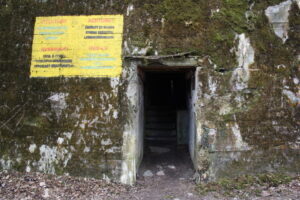
 Valerio and Bellini and identified by the Political Commissar of the partisans’ 52nd Garibaldi Brigade, Urbano Lazzaro. The next day, Mussolini and Petacci were both executed, along with most of the members of their 15-man train, primarily ministers and officials of the Italian Social Republic, in the small village of Giulino di Mezzegra by a partisan leader who used the name de guerre Colonnello Valerio (Not his real name, his real name remains unknown.)
Valerio and Bellini and identified by the Political Commissar of the partisans’ 52nd Garibaldi Brigade, Urbano Lazzaro. The next day, Mussolini and Petacci were both executed, along with most of the members of their 15-man train, primarily ministers and officials of the Italian Social Republic, in the small village of Giulino di Mezzegra by a partisan leader who used the name de guerre Colonnello Valerio (Not his real name, his real name remains unknown.)

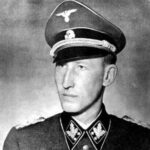 Anytime a government is going to pull off a big change, there must be meetings…planning meetings, if you will. The Third Reich, under Adolf Hitler had long wanted to literally remove the Jewish people from the face of the earth. They began making plans for what they called “The Final Solution to the Jewish Question” and later called the Wannsee Conference to ensure the co-operation of administrative leaders of various government departments in its implementation.
Anytime a government is going to pull off a big change, there must be meetings…planning meetings, if you will. The Third Reich, under Adolf Hitler had long wanted to literally remove the Jewish people from the face of the earth. They began making plans for what they called “The Final Solution to the Jewish Question” and later called the Wannsee Conference to ensure the co-operation of administrative leaders of various government departments in its implementation.
The Wannsee Conference was called by the director of the Reich Security Main Office SS-Obergruppenführer Reinhard Heydrich and included senior government officials of Nazi Germany and Schutzstaffel (SS) leaders. The conference was held in the Berlin suburb of Wannsee on January 20, 1942. The plan of the “Final Solution” was to deport most of the Jews of German-occupied Europe to occupied Poland, where they would be murdered. Hitler was obsessed with what he considered purifying the world. He wanted to build an Aryan race, which is “white non-Jewish people, especially those of northern European origin or descent typically having blond hair and blue eyes and regarded as a supposedly superior racial group.”
In the course of the meeting, Heydrich outlined how European Jews would be rounded up and sent to extermination camps in the General Government (the occupied part of Poland), where they would be killed. Of course, the meetings were merely a formality. The decisions had been made and they were not asking for the support of the attendees, but rather they were simply telling them what they would be doing…if they wanted to live, that is.
Hitler began his discrimination against Jews began immediately after the Nazi seizure of power on January 30, 1933. At first, he employed violence and economic pressure to encourage Jews to voluntarily leave the country. Sadly, the Jews thought that with compliance, they would be ok, but Hitler was determined to remove them from Germany…one way or the other. Then, after the invasion of Poland in September 1939, Hitler stepped up his plan for the extermination of European Jewry and began the killings.
The killings continued and accelerated after the invasion of the Soviet Union in June 1941. On July 31, 1941, Hermann Göring gave written authorization to Heydrich to “prepare and submit a plan for a ‘total solution of the Jewish question’ in territories under German control and to coordinate the participation of all involved government organizations.” At the Wannsee Conference, Heydrich emphasized that “once the deportation  process was complete, the fate of the deportees would become an internal matter under the purview of the SS. A secondary goal was to arrive at a definition of who was Jewish.” Basically, this meant that the Jewish deportees would simply “disappear” into thin air and never be heard from again. Just one copy of the “Protocol” with circulated minutes of the meeting survived the war. It was found by Robert Kempner in March 1947 among files that had been seized from the German Foreign Office. That copy was used as evidence in the subsequent Nuremberg trials. Like many other Holocaust sites, The Wannsee House is now a Holocaust memorial.
process was complete, the fate of the deportees would become an internal matter under the purview of the SS. A secondary goal was to arrive at a definition of who was Jewish.” Basically, this meant that the Jewish deportees would simply “disappear” into thin air and never be heard from again. Just one copy of the “Protocol” with circulated minutes of the meeting survived the war. It was found by Robert Kempner in March 1947 among files that had been seized from the German Foreign Office. That copy was used as evidence in the subsequent Nuremberg trials. Like many other Holocaust sites, The Wannsee House is now a Holocaust memorial.

